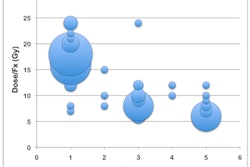Facing a choice of whether to chase the market leaders of linear accelerators whose recent acquisitions have made them stronger, or expand a radiation oncology portfolio with entry-level products, Siemens Healthcare chose the latter, and talked with AuntMinnie.com about its decision to exit the sector.
After notifying all of its radiation oncology customers throughout the world that it was planning to stop manufacturing its Artiste, Oncor, and Primus linear accelerator systems as of January 1, 2012, Siemens stated in a November press release that it would be repositioning its radiation oncology business segment and would not rule out "rightsizing" with linear accelerators. However, it did not announce an exit from the linear accelerator business until earlier this week, leaving the market to its key competitors: Accuray, Elekta, and Varian Medical Systems.
Siemens head of public and media relations Matthias Kraemer, PhD, said that the company had been analyzing market changes based on unstable and recessionary conditions in mature healthcare markets for about a year and a half. In view of cost pressures in the U.S. and increasingly in Europe, Siemens had been planning to invest in both the development of new innovations for radiation oncology and expand its radiation oncology portfolio with entry-level products.
But major changes in the market were occurring, and what they represented made Siemens reassess its strategic plans, Kraemer said. Accuray announced that it would purchase TomoTherapy for $277 million, completing the deal in June. That month oncology firm Elekta announced that it would purchase radiation therapy firm Nucletron for $522.1 million. This acquisition was completed in September. And in September, radiation therapy vendor Varian announced it would purchase electromagnetic localization technology developer Calypso Medical Technologies, a deal completed in November.
"We are strong in the radiation oncology market with our imaging equipment, therapy planning, and after-treatment care, but we were not the top leader of the linac business segment," Kraemer said. "It is a corporate objective to be No. 1 or No. 2 in each market segments."
This strategy was made public with Siemens' announcement in early November of Agenda 2013, a global initiative to enhance innovation, build on its greatest strengths, and become more competitive. "In addition to development of a program to improve the cost position in the diagnostics division, Agenda 2013 includes measures targeting innovation, regional presence, competitiveness, and human resource development over two years," Kraemer said.
The program also included a reallocation of investments and resources to focus on the areas of greatest future development. "It makes sense to develop lower-cost products in radiation oncology for increasingly cost-sensitive mature markets, specifically Europe and North America, and also to target these products to countries like China and India that are rapidly expanding their healthcare systems," Kraemer said.
He emphasized that Siemens is protecting the investment made by its customers in its linac systems. A major software upgrade is scheduled for spring 2012, and customers will be fully supported with technical assistance and maintenance.
Approximately 400 employees in Germany and a much smaller number of employees in the rest of the world will be impacted. Kraemer said that it was the express goal of Siemens to avoid job terminations for operational reasons, and that efforts would be made to transfer affected employees to other positions within the Healthcare division or other company divisions.



















